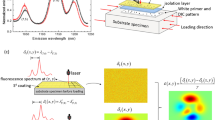Abstract
In this paper we describe an optical-based technique, called strain sensitive skin (S3), for measuring in-plane strain data on structural members under static load. The technique employs a coating consisting of a luminescent dye and polymer binder that is applied to the surface of a test part via conventional aerosol techniques. Proper illumination stimulates the dye, which in turn emits higher wavelength luminescence. The excitation and emission intensities have different wavelengths; therefore, enabling optical filtering to separate the two signals. The optical strain response is intensity based. A network of randomized microcracks within the binder scatters the waveguided luminescence from the excited dye molecules. The amount of scattered luminescence is related to the changes in the microcrack openings and orientations via mechanical strain. Various calibration tests show the optical strain response to be proportional to the sum of in-plane principal strains. With this new experimental testing tool, full-field high-resolution strain measurements can be acquired. The optical strain response of this new sensor is minimally dependent on viewing and lighting directions, rendering the technique viable to imaging and determining strain fields for three-dimensional complex geometries.
Similar content being viewed by others
References
Daily, J.W. andRiley, W.F., Experimental Stress Analysis, 3rd ed., McGraw-Hill, New York (1991).
Cloud, G.L., Optical Methods of Engineering Analysis, Cambridge University Press, New York (1998).
Rastogi, P.K., ed., Topics in Applied Physics: Photomechanics, Vol. 77, Springer, Berlin (1999).
Post, D., Han, B., andIfju, P.G., High Sensitivity Moiré: Experimental Analysis for Mechanics and Materials, Springer-Verlag, New York (1994).
Post, D., “Moiré Interferometry,”Handbook on Experimental Mechanics, A.S. Kobayashi, ed., Prentice-Hall, Englewood Cliffs, NJ, chap. 7 (1987).
McDonald, A., McKelvie, J., andWalker, C.A., “Stress Analysis of Fibrous Composites using Moiré Interferometry,”Opt. Lasers Eng.,1(EM4),85–105 (1980).
Morse, S., Durelli, A.J., andSciammarella, C.A., “Geometry of Moiré Fringes in Strain Analysis,”J. Eng. Mech. Div., ASCE,86,105–126 (1960).
Wellar, R. andShepard, B.M., “Displacement Measurement by Mechanical Interferometry,”Proc. SESA,VI(1),35–38 (1948).
Sciammarella, S.A. andDurelli, A.J., “Moiré Fringes as a Means of Analyzing Strains,”J. Eng. Mech. Div. ASCE,87 (EM1),55–74 (1961).
Theocaris, P.S., “Isopachic Patterns by Moiré Method,” EXPERIMENTAL MECHANICS,4(6),153–159 (1964).
Steson, K.A., “Review of Speckle Photography and Interferometry,”Opt. Eng.,14(5),482–489 (1975).
Jones, R. andWykes, C., Holographic and Speckle Interferometry, Cambridge University Press, Cambridge (1983).
Taylor, C.E., “Holography,”Manual on Experimental Stress Analysis, 5th ed., J. Doyle, ed., Society of Experimental Mechanics, Bethel, CT, 136–149 (1989).
Stetson, K.A., andPowell, R.L., “Interferometric Hologram Evaluation and Real-time Vibration Analysis of Diffuse Objects,”J. Opt. Soc. Am.,55,1694–1695 (1965).
Zandman, F., Redner, S., andDally, J.W., Photoelastic Coatings, Iowa Press, Ames (1977).
D'Agostino, J., Drucker, D.C., Liu, C.K., andMylonas, C., “Epoxy Adhesives and Casting Resins as Photoelastic Plastics,”Proc. SESA,XII(2),123–128 (1955).
Kawate, K., “Analysis of Elastoplastic Behavior of Metals by Means of Photoelastic Coating Method,”J. Sci. Res. Instrum.,52,17–40 (1958).
Durelli, A.J., Hall, J., andStern, F., “Brittle Coating,”Handbook on Experimental Mechanics, A.S. Kobayashi, ed., Prentice-Hall, Englewood Cliffs, NJ, 516–554 (1987).
Ellis, G., “Practical Strain Analysis by Use of Brittle Coatings,”Proc. SESA,VI(2),68–83 (1949).
Peters, W.H. andRanson, W.F., “Digital Imaging Techniques in Experimental Stress Analysis,”Opt. Eng.,21(3),427–432 (1982).
Sutton, M.A., Cheng, M., Peters, W.H., Chao, Y.J. andMcNeill, S.R., “Applications of an Optimized Digital Correlation Method for Planar Deformation Analysis,”Image Vision Comput.,4,143–150 (1986).
Durelli, A.J. andDeWolf, T.N., “Law of Failure of Stresscoat,”Proc. SESA,6(2),68–83 (1949).
Ifju, P.G., Schanze, K.S., Wang, Y., Hubner, J.P., Jenkins, D.A., El-Ratal, W., Brennan, A.B., He, L., Shen, Y., and Carroll, B., System, Method, and Coating for Strain Analysis, Patent No, 6,327,030 (December 2001).
Bell, J.H., Schairer, E.T., Hand, L.A. andMehta, R.D., “Surface Pressure Measurements Using Luminescent Coatings,”Ann. Rev. Fluid Mech.,33,155–206 (2001).
Frocht, M.M., “Factors of Stress Concentration Photoelastically Determined,”Trans. ASME,57,A-67 (1935).
Author information
Authors and Affiliations
Rights and permissions
About this article
Cite this article
Hubner, J.P., Ifju, P.G., Schanze, K.S. et al. Full-field strain measurement using a luminescent coating. Experimental Mechanics 43, 61–68 (2003). https://doi.org/10.1007/BF02410485
Received:
Revised:
Issue Date:
DOI: https://doi.org/10.1007/BF02410485




